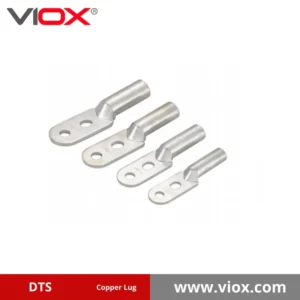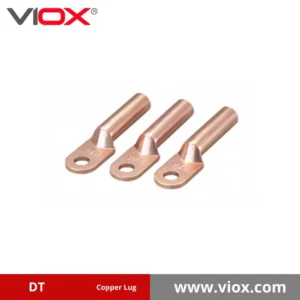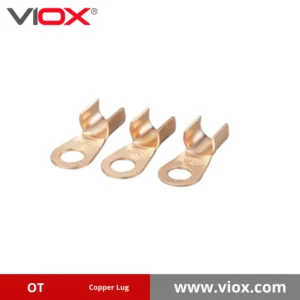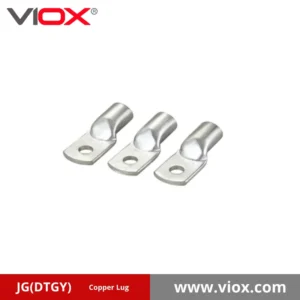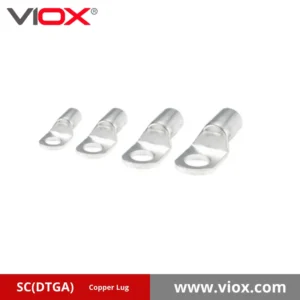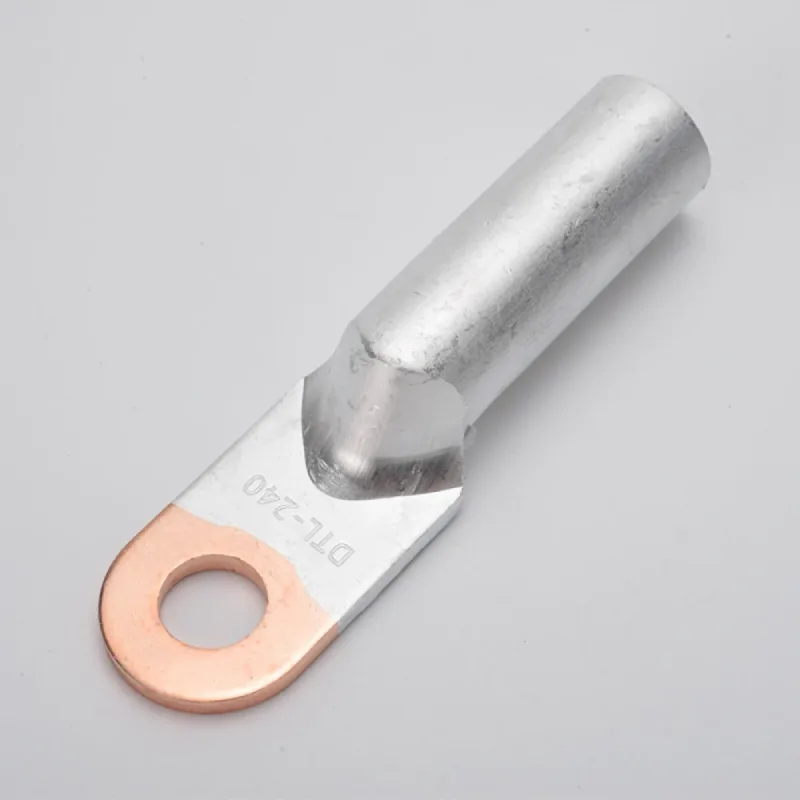
Kabelių antgalių gamintojas - „VIOX Electric Factory“
„VIOX Electric“ yra pirmaujanti kabelių antgalių gamintoja Kinijoje, daugiau nei 15 metų specializuojasi aukštos kokybės elektros jungčių sprendimuose. Esame profesionali kabelių antgalių gamykla, gaminanti platų varinių, aliuminio ir bimetalinių kabelių antgalių asortimentą, atitinkantį tarptautinius standartus, įskaitant CSA, CE ir ISO sertifikatus.
Mūsų kabelių antgalių gamybos įmonė siūlo tiesiogiai gamyklai taikomas kainas neaukodama kokybės, todėl esame pirmenybė teikiama elektros rangovams, pramonės objektams ir infrastruktūros projektams visame pasaulyje. Nuo standartinių kabelių antgalių konfigūracijų iki individualių sprendimų – „VIOX Electric“ derina pažangias gamybos technologijas su griežta kokybės kontrole, kad užtikrintų, jog kiekvienas kabelių antgalis atitiktų aukščiausius eksploatacinius standartus.
Sertifikuota pagal





VIOX varinis kabelio antgalis
VIOX bimetalinis kabelio antgalis
VIOX aliuminio kabelio antgalis
Trumpas savęs įvardijimas: Kodėl verta rinktis VIOX Electric?
"VIOX Electric" jau daugiau nei 15 metų esame pirmaujanti aukštos kokybės kabelių antgalių ir elektros jungčių sprendimų gamintoja. Dėl mūsų įsipareigojimo siekti kokybės ir naujovių mus renkasi elektros rangovai, pramonės objektai ir infrastruktūros projektai visame pasaulyje.

- Sukurta siekiant tobulumo: Kiekvienas kabelio antgalis griežtai kontroliuojamas ir testuojamas.
- Visuotinė atitiktis: Mūsų gaminiai atitinka IEC, UL, CSA ir kitus tarptautinius standartus.
- Išskirtinis laidumas: Aukščiausios kokybės medžiagos užtikrina minimalų pasipriešinimą ir galios praradimą
- Platus pasirinkimas: Vienas išsamiausių pramonėje dydžių ir konfigūracijų asortimentas
- Techninis palaikymas: Mūsų inžinierių komanda teikia profesionalias rekomendacijas dėl jūsų konkrečios programos
- Konkurencinga kainodara: Tiesioginė gamyklinė kainodara nesumažinant kokybės
"VIOX" PILNO DIAPAZONO KABELIO ANTGALIS
Mūsų platus kabelių antgalių asortimentas sukurtas taip, kad atitiktų beveik visus elektros jungčių reikalavimus įvairiose pramonės šakose.
- Variniai kabelių antgaliai
- Alavuoti variniai antgaliai
- Aliuminio antgaliai
- Bimetaliniai antgaliai
- Suvirinimo kabelių antgaliai
- Vamzdiniai antgaliai
- Varinių vamzdžių gnybtai
- Kabelio antgalio kaiščio tipas
- Kabelių sujungimas
- Iš anksto izoliuoti antgaliai
- Iš anksto izoliuota jungtis
- Mechaninis antgalis
- Mechaninė jungtis
- Skelto varžto jungtis
- C jungtis
- Varinio kabelio jungtis
- Aliuminio kabelio jungtis










"VIOX" kabelių antgalių dydžių diagrama
| MODELIS | DIMENSIJA | VAL STORIS | |||||||
|---|---|---|---|---|---|---|---|---|---|
| D±0.2 | D±0.2 | G±0.3 | L±1.5 | L1±1 | W±1 | Φ±0.5 | |||
| JG10-6 | 8 | 5.6 | 2.5 | 38 | 21 | 12 | 6.5 | 1.2 | |
| JG10-8 | 8 | 5.6 | 2.3 | 38 | 21 | 13 | 8.5 | 1.2 | |
| JG16-6 | 9 | 6.4 | 3.0 | 40 | 23 | 13 | 6.5 | 1.3 | |
| JG16-8 | 9 | 6.4 | 3.0 | 40 | 23 | 13 | 8.5 | 1.3 | |
| JG25-6 | 10 | 7.3 | 2.8 | 45 | 25 | 14 | 6.5 | 1.35 | |
| JG25-8 | 10 | 7.3 | 2.8 | 45 | 25 | 14 | 8.5 | 1.35 | |
| JG35-8 | 11 | 8.2 | 3.0 | 50 | 28 | 15 | 8.5 | 1.4 | |
| JG35-10 | 11 | 8.2 | 3.0 | 50 | 28 | 15 | 10.5 | 1.4 | |
| JG50-8 | 13 | 10 | 3.0 | 54 | 30 | 19 | 8.5 | 1.5 | |
| JG50-10 | 13 | 10 | 3.0 | 54 | 30 | 19 | 10.5 | 1.5 | |
| JG70-8 | 16 | 12 | 3.7 | 61 | 33 | 23 | 8.5 | 1.5 | |
| JG70-10 | 16 | 12 | 3.7 | 61 | 33 | 23 | 10.5 | 2.0 | |
| JG95-8 | 18 | 14 | 4.2 | 67 | 36 | 26 | 8.5 | 2.0 | |
| JG95-10 | 18 | 14 | 4.2 | 67 | 36 | 26 | 10.5 | 2.0 | |
| JG95-12 | 18 | 14 | 4.2 | 67 | 36 | 26 | 12.5 | 2.0 | |
| JG120-10 | 20 | 16 | 4.8 | 75 | 43 | 29 | 10.5 | 2.0 | |
| JG120-12 | 20 | 16 | 4.8 | 75 | 43 | 29 | 12.5 | 2.0 | |
| JG120-14 | 20 | 16 | 4.8 | 75 | 43 | 29 | 14.5 | 2.0 | |
| JG120-16 | 20 | 16 | 4.8 | 75 | 43 | 29 | 16.5 | 2.0 | |
| JG150-10 | 22 | 17 | 4.0 | 91 | 57 | 32 | 10.5 | 2.5 | |
| JG150-12 | 22 | 17 | 4.0 | 91 | 57 | 32 | 12.5 | 2.5 | |
| JG150-14 | 22 | 17 | 4.0 | 91 | 57 | 32 | 14.5 | 2.5 | |
| JG150-16 | 22 | 17 | 4.0 | 91 | 57 | 32 | 16.5 | 2.5 | |
| JG185-10 | 24 | 19 | 5.0 | 96 | 59 | 35 | 10.5 | 2.5 | |
| JG185-12 | 24 | 19 | 5.0 | 96 | 59 | 35 | 12.5 | 2.5 | |
| JG185-14 | 24 | 19 | 5.0 | 96 | 59 | 35 | 14.5 | 2.5 | |
| JG185-16 | 24 | 19 | 5.0 | 96 | 59 | 35 | 16.5 | 2.5 | |
| JG240-12 | 26 | 21 | 5.0 | 96 | 62 | 39 | 13.0 | 2.5 | |
| JG240-14 | 26 | 21 | 5.0 | 96 | 62 | 39 | 15.0 | 2.5 | |
| JG240-16 | 26 | 21 | 5.0 | 96 | 62 | 39 | 17.0 | 2.5 | |
| JG240-20 | 26 | 21 | 5.0 | 96 | 62 | 39 | 21.0 | 2.5 | |
| JG300-12 | 30 | 24 | 6.0 | 103 | 67 | 43 | 13.0 | 2.5 | |
| JG300-14 | 30 | 24 | 6.0 | 103 | 67 | 43 | 15.0 | 2.5 | |
| JG300-16 | 30 | 24 | 6.0 | 103 | 67 | 43 | 17.0 | 2.5 | |
| JG300-20 | 30 | 24 | 6.0 | 103 | 67 | 43 | 21.0 | 2.5 | |
| MODELIS | D ±0,3 (MM) | D ±0,3 (MM) | L ±1,5 (MM) | L1 ±1,5 (MM) | S ±0,3 (MM) | N ±0,5 (MM) | W ±0,5 (MM) | SIENELIŲ STORIS (MM) |
|---|---|---|---|---|---|---|---|---|
| DT-10 | 9 | 5.8 | 63 | 30 | 2.4 | 8 | 16 | 1.6 |
| DT-16 | 10 | 6.5 | 65 | 32 | 2.6 | 8 | 16 | 1.75 |
| DT-25 | 11 | 7.5 | 70 | 35 | 3.0 | 9 | 18 | 1.75 |
| DT-35ᵀ | 12 | 8.7 | 80 | 38 | 3.2 | 10 | 20 | 1.75 |
| DT-50ᵀ | 14 | 10.0 | 85 | 42 | 3.4 | 11.5 | 23 | 2.0 |
| DT-70 | 16 | 12.0 | 95 | 47 | 4.0 | 13 | 26 | 2.0 |
| DT-95 | 18 | 14.0 | 103 | 48 | 4.5 | 14 | 28 | 2.0 |
| DT-120 | 20 | 15.5 | 111 | 52 | 4.8 | 15 | 30 | 2.25 |
| DT-150ᵀ | 22 | 17.0 | 121 | 56 | 5.5 | 17 | 34 | 2.5 |
| DT-185 | 25 | 19.0 | 125 | 59 | 6.0 | 18 | 38 | 3.0 |
| DT-240 | 27 | 21.5 | 135 | 60 | 6.6 | 20 | 40 | 2.75 |
| DT-300 | 30 | 23.5 | 152 | 68 | 7.3 | 25 | 50 | 3.25 |
| DT-400 | 34 | 27.0 | 170 | 76 | 8.5 | 28 | 55 | 3.5 |
| DT-500 | 38 | 29.0 | 186 | 86 | 9.0 | 31 | 55 | 3.75 |
| DT-630 | 45 | 35.0 | 210 | 86 | 9.0 | 31 | 60 | 3.75 |
Gaukite savo Nemokamas kabelio antgalis
Mes nemokamai pateikiame pavyzdžių, jums tereikia pasakyti, ko jums reikia.
Daugiau nei tik kabelių antgalių gamintojas
"VIOX" ne tik gamina kabelių antgalius, bet ir siūlo pridėtinės vertės paslaugų rinkinį, pritaikytą jūsų projekto poreikiams. Mūsų įsipareigojimas siekti meistriškumo užtikrina, kad kiekvienas klientas gautų asmeninį dėmesį, ekspertų konsultacijas ir sklandžią paramą viso bendradarbiavimo su mumis metu.

Konsultacijos dėl paslaugų
Nesvarbu, ar jūsų kabelių antgalių reikalavimai yra paprasti, ar sudėtingi, mūsų komanda teikia profesionalius patarimus ir technines konsultacijas. Sudėtingesniems projektams siūlome išsamią inžinerinę pagalbą, kad užtikrintume optimalų gaminio pasirinkimą ir pritaikymą.

Produktų rekomendacijos
Nežinote, kuris kabelio antgalis tinka jūsų maitinimo sistemai? Mūsų specialistai, atsižvelgdami į konkrečius eksploatacinius ir aplinkosaugos reikalavimus, teikia nemokamas individualias rekomendacijas ir užtikrina, kad jie jums puikiai tiks.

Logistinė parama
Jei neturite patikimo ekspeditoriaus, galime be papildomų išlaidų pasirūpinti transportavimu iš mūsų gamyklos į jūsų projekto vietą. Mūsų logistikos komanda užtikrina savalaikį ir saugų pristatymą, kad jūsų projektas būtų vykdomas pagal grafiką.

Įrengimo palaikymas
Reikia pagalbos diegiant? Mūsų technikos komanda gali atsakyti į jūsų klausimus arba suteikti praktinę pagalbą. Įgyvendindami didesnius projektus, galime net išsiųsti inžinierių į jūsų vietą, kad jis padėtų vietoje.
Dažnai užduodami klausimai
Surinkome keletą dažniausiai klientų užduodamų klausimų. Jei jūsų klausimas čia nepateiktas, mūsų klientų aptarnavimo tarnyba visada pasiruošusi padėti. Mielai su jumis pasikalbėsime.
Kaip galiu gauti pasiūlymą dėl kabelio kilpos
Norėdami gauti mūsų kabelio antgalio pasiūlymą, susisiekite su mūsų klientų aptarnavimo komanda. Esame pasiekiami 24 valandas per parą, 7 dienas per savaitę. Tiesiog nurodykite užsakymo ypatumus, pavyzdžiui, tipą, dydį ir kiekį. Mes padėsime jums atlikti visą užsakymo procesą.
Koks yra jūsų užsakymo MOQ?
Turime mažą MOQ arba minimalų užsakymo kiekį. Galite užsisakyti vos vieną vienetą, o mes pristatysime pagal jūsų specifikacijas.
Koks yra mano užsakymo įvykdymo laikas?
Standartinis mūsų kabelių antgalių užsakymo laikas yra nuo 7 iki 10 darbo dienų. Dėl tranzito pristatymo laikas gali pailgėti iki 15 darbo dienų. Jei užsakoma pagal užsakymą arba dideliais kiekiais, prieš baigdami užsakymą galime aptarti apyvartos trukmę.
Ar galiu gauti pavyzdį prieš pateikdamas užsakymą?
Taip, pateikiame pavyzdžių, kad galėtumėte juos įvertinti ir patvirtinti. Pavyzdžių kūrimas paprastai trunka nuo 3 iki 7 darbo dienų.
Ar galite pasidaryti kabelio kilpą
Taip, mes siūlome individualų kabelio antgalį. Praneškite mums apie savo reikalavimus, ir mūsų klientų aptarnavimo specialistų komanda dirbs su jumis projektavimo procese.
Kokia yra jūsų garantija kabelio lizdui
Visiems mūsų gaminamiems kabelių antgaliams suteikiame 3 metų garantiją. Tai užtikrina, kad pristatome aukštos kokybės gaminius. Prieš pristatydami kiekvieną gaminį jį kruopščiai išbandome.
Kai kas apie kabelio antgalį
Kas yra kabelių antgaliai ir kodėl jie svarbūs?
Kabelių antgaliai - tai laidūs įtaisai, tvirtinami prie elektros kabelių galų, kad juos būtų lengviau prijungti prie elektros gnybtų. Jie sukuria švarų ir saugų galą, kuris užtikrina maksimalų elektrinį kontaktą ir apsaugo nuo jungties gedimo.
Kabelių antgalių svarba neapsiriboja vien tik jungtimi:
- Saugos didinimas: Tinkamai sumontuoti kabelių antgaliai sumažina elektros gaisrų, trumpųjų jungimų ir kitų pavojų riziką.
- Padidintas laidumas: Jie užtikrina optimalų elektros srautą su minimaliu pasipriešinimu.
- Prailgintas įrangos eksploatavimo laikas: Kokybiški kabelių gnybtai apsaugo ir kabelį, ir prijungtą įrangą nuo pažeidimų.
- Kodekso laikymasis: Daugelyje elektros kodų ir standartų reikalaujama tinkamų kabelių galų dėl saugos ir eksploatacinių savybių.
Kabelio antgalio funkcijos
- Elektros instaliacija: Srovei tekėti iš kabelio į galinį tašką skirtas labai laidus, mažos varžos kelias.
- Mechaninis: Tvirtinti kabelį, kad jis neišsitrauktų dėl vibracijos ar įtempimo.
Kabelio antgalio tipai
Kabelių antgaliai būna įvairių tipų ir gaminami iš skirtingų medžiagų, kad atitiktų konkrečius elektros jungčių poreikius. Pagrindinės medžiagos yra šios:
Variniai antgaliai: Pagaminti iš didelio laidumo vario (99,9% grynumo), jie pasižymi puikiomis elektrinėmis savybėmis, minimalia varža ir geru atsparumu tempimui, todėl idealiai tinka optimaliai efektyviam naudojimui.
Aliuminio antgaliai: Lengvos ir ekonomiškos alternatyvos, išpopuliarėjusios septintajame dešimtmetyje, nors jas reikėjo patobulinti po to, kai pradžioje kilo problemų dėl aliuminio oksido susidarymo.
Alavuoti variniai antgaliai: Variniai antgaliai su apsaugine alavo danga (3-5 μm storio), padidinančia atsparumą korozijai, todėl tinka naudoti atšiaurioje ar drėgnoje aplinkoje.
Žalvario antgaliai: Šios dangos pasižymi puikiu patvarumu ir atsparumu aukštoms temperatūroms, todėl užtikrina gerą apsaugą nuo korozijos, ypač jūrinėse sistemose.
Konstrukcijos variantai: žiediniai gnybtai (apvalus galas su centrine skyle), šakutės ir (arba) kastuvo gnybtai (atviras galas, kad būtų lengviau montuoti ir (arba) išimti) ir kaištiniai gnybtai (tvirtas kaištinis galas, skirtas gnybtų blokams).Prijungimo būdai yra įvairūs: nuo suspaudimo antgalių, kuriems reikia užspaudimo įrankių, iki mechaninių antgalių, kuriems saugiai pritvirtinti naudojami varžtai arba varžtai su kirpimo galvutėmis.
Kaip pasirinkti tinkamą kabelio lizdą
Pasirinkus netinkamą antgalį, gali nukentėti visa jungtis. Atlikite šiuos veiksmus, kad tinkamai kabelių antgalių dydžių nustatymas ir atranka:
- Suderinkite laidininko medžiagą: Variniams kabeliams naudokite varinius antgalius, aliumininiams kabeliams - aliumininius antgalius. Jungdami aliuminio kabelį prie varinių įrenginių ir (arba) galinių išvadų, naudokite dvimetalius antgalius.
- Nustatykite tinkamą laidininko dydį (AWG/kcmil arba mm²): Tai nediskutuotina. Kabelio antgalis turi būti tikslaus dydžio, atitinkančio kabelio storį (pvz., 4 AWG, 2/0 AWG, 25 mm², 120 mm²). Naudojant per mažą antgalį, kabelis netelpa, o naudojant per didelį - blogai suspaudžiamas, atsiranda didelė varža ir galimas gedimas. Žiūrėkite gamintojo kabelių antgalių dydžių nustatymas diagramos.
[Paveikslas: kabelių antgalių dydžių lentelės pavyzdys] - Patikrinkite smeigės skylės dydį: Skylė antgalio liežuvėlyje turi atitikti gnybto kaiščio arba varžto, prie kurio jis bus tvirtinamas, skersmenį (pvz., 1/4″, 3/8″, M6, M10). Dėl per didelės skylės kontaktas bus prastas.
- Atsižvelkite į įtampą ir srovės stiprį: Nors dažnai tai lemia kabelio dydis, įsitikinkite, kad pats antgalis (ypač mechaninio tipo) yra tinkamai įvertintas pagal sistemos įtampą ir numatomą nuolatinę / pikinę srovę.
- Įvertinkite aplinkos sąlygas: Ar jungtis bus veikiama drėgmės, druskos, cheminių medžiagų arba aukštos temperatūros? Dėl to reikia naudoti alavuotą varį, specifinį padengimą arba sandarias jungtis (naudojant terminį susitraukimą).
- Patikrinkite, ar yra reikalaujamų standartų ir sertifikatų: Daugelyje sričių (ypač pramoninių, komunalinių ir saugai svarbių) kilpos turi atitikti tam tikrus standartus. Ieškokite ženklinimo, nurodančio atitiktį (pvz, UL įregistruoti antgaliai(UL 486A-486B), CSA sertifikatas, DIN). Naudojant sertifikuotus komponentus užtikrinamas patikrintas veikimas ir saugumas.
Kaip teisingai sumontuoti kabelių antgalius
Tinkamas kabelių antgalių montavimas yra ne mažiau svarbus nei teisingas pasirinkimas. Netinkamas užspaudimas - tai gedimas, kuris tik ir laukia savo valandos. Štai kaip užspausti kabelių antgalius veiksmingai:
Surinkite įrankius ir medžiagas
- Tinkamo dydžio kabelių antgaliai
- Kabelis / laidas
- Kalibruotas kabelių antgalių užspaudimo įrankis naudodami tinkamą matricų rinkinį, specialiai sukurtą tam tikram antgalio dydžiui ir tipui (šešiakampės matricos paprastai naudojamos didesniems antgaliams, o mažesniems - įdubimo tipo). Naudojant replės arba netinkamą įrankį, užspaudimas bus nekokybiškas.
- Kabelių nuėmiklis
- Vielinis šepetys (būtinas aliuminio laidininkams)
- Oksido inhibitoriaus junginys (būtinas aliuminio laidininkams)
- Pasirinktinai: termo susitraukimo vamzdeliai ir šiluminis pistoletas
Paruoškite kabelio galą
- Nukirpkite izoliaciją iki reikiamo ilgio, kurį nurodė antgalio gamintojas (paprastai tokio pat gylio, kaip cilindro gylis). Venkite nutraukti laidininko gijas.
- Aliuminio kabeliams: Kabelių kabelius: Stipriai šepetėliu nuvalykite atviras laidininkų gijas, kad pašalintumėte paviršinį oksido sluoksnį. iš karto prieš įkišdami į ąselę. Gausiai užtepkite oksidų inhibitoriaus mišinio ant vijų.
Įkiškite kabelį į kilpos cilindrą
- Šiek tiek susukite daugiasiūlius laidininkus (jei reikia), kad gijos laikytųsi kartu.
- Paruoštą laidininką iki galo įkiškite į antgalio cilindrą. Jei antgalis turi stebėjimo angą (apžiūros langelį), patikrinkite, ar laidininkas matomas ir ar jis visiškai įkištas.
Lemiamas žingsnis: Lanksto užspaudimas
- Štai koks yra susitarimas: Presavimas fiziškai suformuoja tūtelę ir laidininką į vientisą masę be tuštumų.
- Pasirinkite tinkamą presavimo įrankio matricų rinkinį, atitinkantį antgalio dydį ir tipą (dažnai pažymėtą ant antgalio).
- Teisingai įstatykite antgalį į štampą pagal įrankio ir antgalio gamintojo instrukcijas (ant antgalio korpuso dažnai būna pažymėta užspaudimo vieta). Ilgų korpusų antgaliams gali prireikti kelių užspaudimų.
- Įjunkite presavimo įrankį (rankinį, hidraulinį arba akumuliatorinį). Užtikrinkite, kad įrankis užbaigtų visą užspaudimo ciklą (reketiniai įrankiai paprastai atsilaisvina tik po viso ciklo). Neužspauskite per mažai arba per daug.
Patikrinkite suspaudimo kokybę
- Nepraleiskite šio žingsnio! Labai svarbu atlikti vizualinę ir mechaninę patikrą.
- Vizualinis patikrinimas: Atkreipkite dėmesį į įspaudo kodo ženklą, įspaustą ant užspausto cilindro (tai patvirtina, kad buvo naudotas tinkamas įspaudas). Užspaudimas turi būti tolygus, be pernelyg didelio blyksnio (metalas išspaustas į šoną). Jei antgaliai yra su matomomis skylutėmis, įsitikinkite, kad laidininkas vis dar matomas.
- Mechaninis patikrinimas: Švelniai patraukite kabelį, kad įsitikintumėte, jog jis patikimai laikosi antgalyje. Tinkamas užspaudimas sukuria stipresnį ryšį nei pats kabelis.
Pasirinktinai: Jungties sandarinimas
- Tinkamo dydžio termo susitraukiančią žarnelę užmaukite ant antgalio cilindro ir ant kabelio izoliacijos.
- Šilumos pistoletu tolygiai sutraukite vamzdelius. Taip užtikrinama elektrinė izoliacija, mechaninis įtempių mažinimas ir sandarinama jungtis nuo drėgmės ir teršalų.
Kabelių antgaliai ir alternatyvos
Nors kabelių antgaliai yra standartinės jungtys, skirtos didesniems kabeliams ant smeigių ar magistralinių strypų užbaigti, tačiau yra ir kitokių jungčių:
- Gnybtų blokai: Naudojamas keliems laidams sujungti arba elektros energijai paskirstyti korpusuose. Geriau tinka mažesnio diametro laidams ir tais atvejais, kai reikia lengvai modifikuoti.
- Sujungimai (sujungimai į apačią / lygiagretieji sujungimai): Naudojamas dviem kabeliams sujungti galu į galą arba kabelio linijai atjungti.
- Kaiščių gnybtai / antgaliai: Naudojamas vielos gijoms sujungti, kad būtų galima jas įstatyti į sraigtinius gnybtus.
Kabelių antgaliai puikiai tinka tais atvejais, kai reikalingas saugus, didelės srovės, tiesioginis prijungimas prie įrangos arba smeigės.
Kabelių antgalių gamybos procesas
Procesas pradedamas nuo didelio laidumo EB klasės vario arba aliuminio, paprastai vamzdžių (vamzdiniams antgaliams) arba lakštų (štampuotiems antgaliams), parinkimo. Ši medžiaga tiksliai supjaustoma pagal ilgį.
Po to specializuotos mašinos formuoja medžiagą į būdingą ąselės korpusą (skirtą kabeliui) ir delną (plokščią tvirtinimo dalį), pavyzdžiui, presavimo, štampavimo arba kalimo būdu. Tuomet delninėje dalyje išmušamos skylės varžtams ar varžtams, o kraštai užglaistomi.
Siekiant didesnio lankstumo, kai kurie antgaliai atkaitinami (termiškai apdorojami). Svarbiausias etapas - paviršiaus apdorojimas, dažniausiai alavu, kuris suteikia esminį atsparumą korozijai.
Galiausiai ant antgalių įspaudžiami identifikavimo ženklai (dydis, gamintojas), atliekama griežta kokybės kontrolė (tikrinami matmenys, stiprumas, laidumas), tada jie išvalomi ir supakuojami platinimui. Šiuolaikinėje gamyboje, siekiant efektyvumo ir nuoseklumo, daug dėmesio skiriama automatizuotoms gamybos linijoms.
Kabelių antgalių standartai ir sertifikatai
Kokybiški kabelių antgaliai atitinka įvairius pramonės standartus:
- UL (Underwriters Laboratories): Užtikrinami saugos ir eksploataciniai reikalavimai.
- CSA (Kanados standartų asociacija): Kanados sertifikavimas panašus į UL
- IEC (Tarptautinė elektrotechnikos komisija): Tarptautiniai elektros komponentų standartai
- NEMA (Nacionalinė elektros gamintojų asociacija): Pramonės standartai, taikomi elektros įrangai
- IEEE (Elektros ir elektronikos inžinierių institutas): Elektros sistemų techniniai standartai
Pirkdami kabelių antgalius ieškokite šių sertifikatų, kad užtikrintumėte kokybę ir saugumą.
"Yueqing & VIOX ELECTRIC": lyderiauja kabelių antgalių rinkoje
Yueqing, pripažintas "Kinijos elektrotechnikos miestu", yra pasaulinis gamybos centras. kabelių antgaliai, remiama strateginės vyriausybės paramos, kuri padeda išlaikyti konkurencinį pranašumą nepaisant rinkos iššūkių.
Žymūs gamintojai, pvz. VIOX ELECTRIC iliustruoja "Yueqing" įsipareigojimą siekti kokybės ir reikšmingai prisideda prie stiprios įmonės padėties tarptautinėje rinkoje.
Prognozuojama, kad pasaulinė kabelių antgalių rinka stipriai augs (5,4%-9,5% CAGR iki 2033 m.), todėl "Yueqing", kurioje dalyvauja tokie pagrindiniai žaidėjai kaip VIOX ELECTRIC, yra pagrindinis aukštos kokybės ir patikimų elektros komponentų šaltinis.
Užsisakykite kabelio antgalį
"VIOX Electric" yra pasirengusi padėti jums patenkinti jūsų OEM kabelių antgalių poreikius. Siūlome aukštos kokybės ir ekonomiškus sprendimus.


